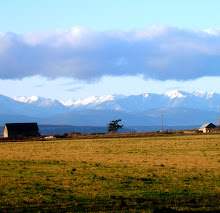Thus began the process to turn this historical document into a full lenght theatrical production. "Rebecca -- the story of Rebecca Ebey" will premier on March 23, 2012 at the Whidbey Island Center for the Arts as a part of their Local Artists Series.
"Rebecca is the story of a woman -- and the pioneer community she helped found here on Whidbey," says Jill. "But it is also a story about a place...where the wind and the rain and the seabirds circling in the fields are much the same as they were when Isaac and Rebecca were here."
 |
| Ebey's Landing, Photo by Dan Pedersen |
A grant form the National Storytelling Network, a national storytelling organization, helped Jill complete research at the Special Collections Library at the University of Washington. Weeks of research into the letters and correspondence of the Davis and Ebey families deepened and enriched the story.
But the diary remains the core of the production. "It's an intensely personal document," says Jill, "allowing Rebecca to pour out thoughts she would never have spoken aloud: her joy in the warmth and love of family and the beauty of the land, pride in the development of the tiny community and the region, frustration and fear of the challenges she faced."
 |
| Jill's image of "Rebecca", from the files of Ebey's Landing National Historical Reserve |
"I can see it now...the land. It stretches out -- bands of green, yellow, and black: squash fields, hay stubble, and black earth, ringed by forest and shore. For centuries Native Americans gathered camas root and nettles on this prairie and then burned it...year after year, layer after layer of ash, rich in nutrients which became ithe farms and fields of Ebey's Landing. I stroll down the road, munching apples from a tree near the Ferry House. The wind whistles in my ear and I can hear the surf sounds below. Rebecca heard those same sounds; yesterday was teh 158th anniversary of her death. Now...for just a moment...it is almost as if we share this landscape together."
 |
| Prairie Bottoms, Photo by Amos Morgan |






























 What can we learn by looking into the eyes of the past?
What can we learn by looking into the eyes of the past? 




 Who were they? What were they like?
Who were they? What were they like?


 Field trip participants visit the
Field trip participants visit the  Lauren Hubbard and Shelby
Lauren Hubbard and Shelby 






